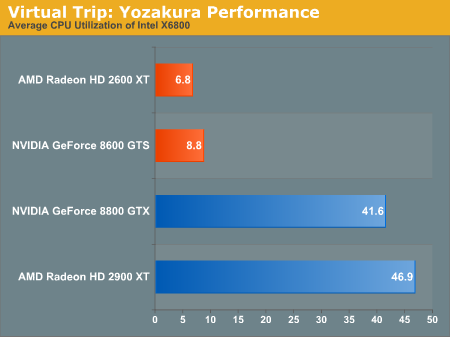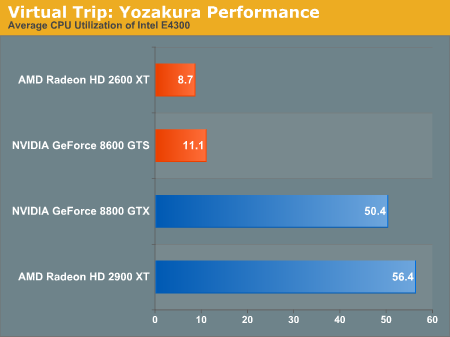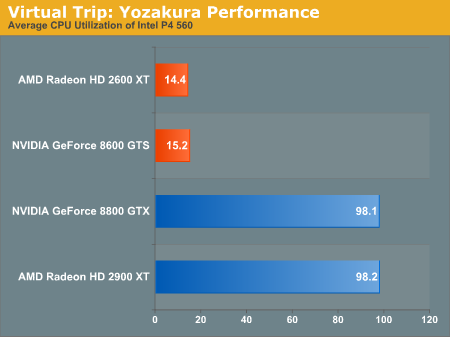HD Video Decode Quality and Performance Summer '07
by Derek Wilson on July 23, 2007 5:30 AM EST- Posted in
- GPUs
Yozakura (High Complexity H.264) Performance
H.264 offers quite a range of options, and we haven't seen everyone taking advantage of some of the more advanced features. Yozakura is encoded in 1080i at 25 Mbps. This is fairly low for H.264 maximums, but this is still very CPU intensive because the video is encoded using macroblock adaptive frame/field (MBAFF) coding. MBAFF is a high quality technique to ensure maximum visual fidelity in interlaced video by adaptively selecting frame or field encoding per macroblock based on a motion threshold.
While 1080p is clearly Hollywood's choice of resolution, there is 1080i encoded content out there now and more likely to come. As TV shows transition to HD, we will likely see 1080i as the choice format due to the fact that this is the format in which most HDTV channels are broadcast (over-the-air and otherwise), 720p being the other option. It's nice to know that H.264 offers high quality interlaced HD encoding options, and we hope content authors who decide to release their creations in 1080i will take advantage of things like MBAFF.
Additionally, good deinterlacing is essential for getting a good experience with movies like this. Poorly deinterlaced HD content is not only sad to watch, but gives this author quite a headache. Jaggies and feathering are horrible distractions at this resolution. As long as you stick with an HD 2600 or GeForce 8600 series or higher you should be fine here. Any slower just won't cut it when trying to watch 1080i on a progressive scan display.

Our high end CPU is able to cope fairly well, with the 8800 GTX besting the 2900 XT in performance while UVD leads VP2 putting the 2600 XT ahead of the 8600 GTS.

For our cheap yet current processor, we do see utilization go up, but the hardware with bitstream decoding maintains very low overhead. All of our GPUs maintain good performance when paired with this level of processor. Of course, we would likely not see the high end GPUs matched with such a CPU (unless we are looking at notebooks, but that's a whole other article).

For our older hardware, Yozakura is simply not watchable without bitstream decoding. With the numbers for the high end AMD and NVIDIA GPUs even worse than under our Transporter 2 trailer test, it's clear that NetBurst does not like whatever Yozakura is doing. It may be that decoding the bitstream when MBAFF is used is branch heavy causing lots of stalls. All we can say for sure is that, once again, GPU accelerated bitstream decoding is necessary to watch H.264 content on older/slower hardware.
H.264 offers quite a range of options, and we haven't seen everyone taking advantage of some of the more advanced features. Yozakura is encoded in 1080i at 25 Mbps. This is fairly low for H.264 maximums, but this is still very CPU intensive because the video is encoded using macroblock adaptive frame/field (MBAFF) coding. MBAFF is a high quality technique to ensure maximum visual fidelity in interlaced video by adaptively selecting frame or field encoding per macroblock based on a motion threshold.
While 1080p is clearly Hollywood's choice of resolution, there is 1080i encoded content out there now and more likely to come. As TV shows transition to HD, we will likely see 1080i as the choice format due to the fact that this is the format in which most HDTV channels are broadcast (over-the-air and otherwise), 720p being the other option. It's nice to know that H.264 offers high quality interlaced HD encoding options, and we hope content authors who decide to release their creations in 1080i will take advantage of things like MBAFF.
Additionally, good deinterlacing is essential for getting a good experience with movies like this. Poorly deinterlaced HD content is not only sad to watch, but gives this author quite a headache. Jaggies and feathering are horrible distractions at this resolution. As long as you stick with an HD 2600 or GeForce 8600 series or higher you should be fine here. Any slower just won't cut it when trying to watch 1080i on a progressive scan display.

Our high end CPU is able to cope fairly well, with the 8800 GTX besting the 2900 XT in performance while UVD leads VP2 putting the 2600 XT ahead of the 8600 GTS.

For our cheap yet current processor, we do see utilization go up, but the hardware with bitstream decoding maintains very low overhead. All of our GPUs maintain good performance when paired with this level of processor. Of course, we would likely not see the high end GPUs matched with such a CPU (unless we are looking at notebooks, but that's a whole other article).

For our older hardware, Yozakura is simply not watchable without bitstream decoding. With the numbers for the high end AMD and NVIDIA GPUs even worse than under our Transporter 2 trailer test, it's clear that NetBurst does not like whatever Yozakura is doing. It may be that decoding the bitstream when MBAFF is used is branch heavy causing lots of stalls. All we can say for sure is that, once again, GPU accelerated bitstream decoding is necessary to watch H.264 content on older/slower hardware.










63 Comments
View All Comments
bpt8056 - Monday, July 23, 2007 - link
Does it have HDMI 1.3??phusg - Monday, July 23, 2007 - link
Indeed, which makes it strange that he gave the nvidia cards 100% scores! Sure manual control on the noise filter is nice, but 100% is 100% Derek. It working badly when set above 75% makes for a less than perfect HQV score IMHO. Personally I would have gone with knocking off 5 points from the nvidia card's noise scores for this.
Scrogneugneu - Monday, July 23, 2007 - link
I would have cut points back too, but not because at 100% the image quality goes down. There's no sense in providing a slider if every position on the slider gives the same perfect image, doesn't it?Giving a slider, however, isn't very user-friendly, from an average Joe's perspective. I want to dump my movie in the player and listen to it, and I want it to look great. I do not want to move a slider around for every movie to get a good picture quality. Makes me think about the Tracking on old VHS. Quite annoying.
From a technological POV, yes, NVidia's implementation enables players to be great. From a consumer's POV, it doesn't. I wanna listen to a movie not fine tune my player.
Chunga29 - Monday, July 23, 2007 - link
It's all about the drivers, people! TechReport did their review with older drivers (at least on the NVIDIA side). So in the past two weeks, NVIDIA apparently addressed some problems and AT took a look at the current results. Probably delayed the article a couple times to rerun tests as well, I bet!As for the above comment about the slider, what you're failing to realize is that noise reduction impacts the final output. I believe Sin City used a lot of noise intentionally, so if you watch that on ATI hardware the result will NOT be what the director wanted. A slider is a bit of a pain, but then being a videophile is also a pain at times. With an imperfect format and imperfect content, we will always have to deal with imperfect solutions. I'd take NVIDIA here as well, unless/until ATI offers the ability to shut off NR.
phusg - Monday, July 23, 2007 - link
Hi Derek,Nice article, although I've just noticed a major omission: you didn't bench any AGP cards! There are AGP versions of the 2600 and 2400 cards and I think these are very attractive upgrades for AGP HTPC owners who are probably lacking the CPU power for full HD. The big question is whether the unidirectional AGP bus is up to the HD decode task. The previous generation ATi X1900 AGP cards reportedly had problems with HD playback.
Hopefully you'll be able to look into this, as AFAIK no-one else has yet.
Regards, Pete
ericeash - Monday, July 23, 2007 - link
i would really like to see these tests done on an AMD x2 proc. the core 2 duo's don't need as much offloading as we do.Orville - Monday, July 23, 2007 - link
Derek,Thanks so much for the insightful article. I’ve been waiting on it for about a month now, I guess. You or some reader could help me out with a couple of embellishments, if you would.
1.How much power do the ATI Radeon HD 2600 XT, Radeon HD 2600 Pro, Nvidia GeForce 6800 GTS and GeForce 6800 GT graphics cards burn?
2.Do all four of the above mentioned graphics cards provide HDCP for their DVI output? Do they provide simultaneous HDCP for dual DVI outputs?
3.Do you recommend CyberLink’s Power DVD video playing software, only?
Regards,
Orville
DerekWilson - Monday, July 23, 2007 - link
we'll add power numbers tonight ... sorry for the omissionall had hdcp support, not all had hdcp over dual-link dvi support
powerdvd and windvd are good solutions, but powerdvd is currently further along. we don't recommend it exclusively, but it is a good solution.
phusg - Wednesday, July 25, 2007 - link
I still can't see them, have they been added? Thanks.GlassHouse69 - Monday, July 23, 2007 - link
I agree here, good points.15% cpu utilization looks great until.... you find that a e4300 takes so little power that to use 50% of it to decode is only 25 watts of power. It is nice seeing things offloaded from the cpu.... IF the video card isnt cranking up alot of heat and power.